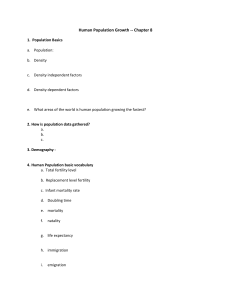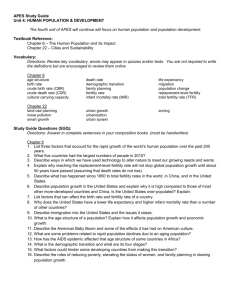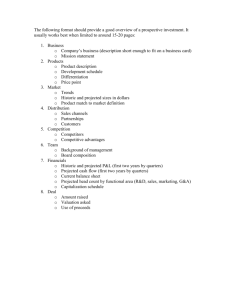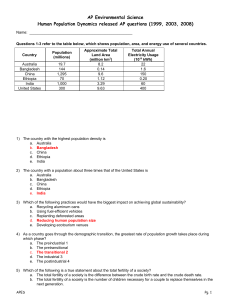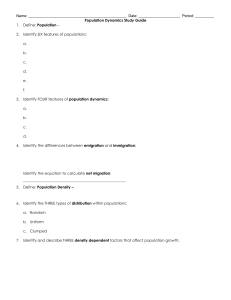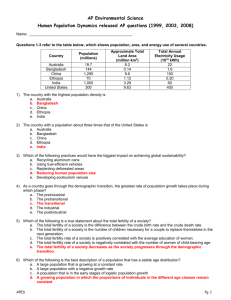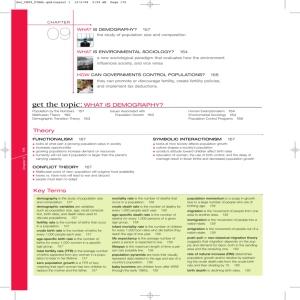APES Ch. 9: Human Population Growth Vocabulary Age structure
advertisement
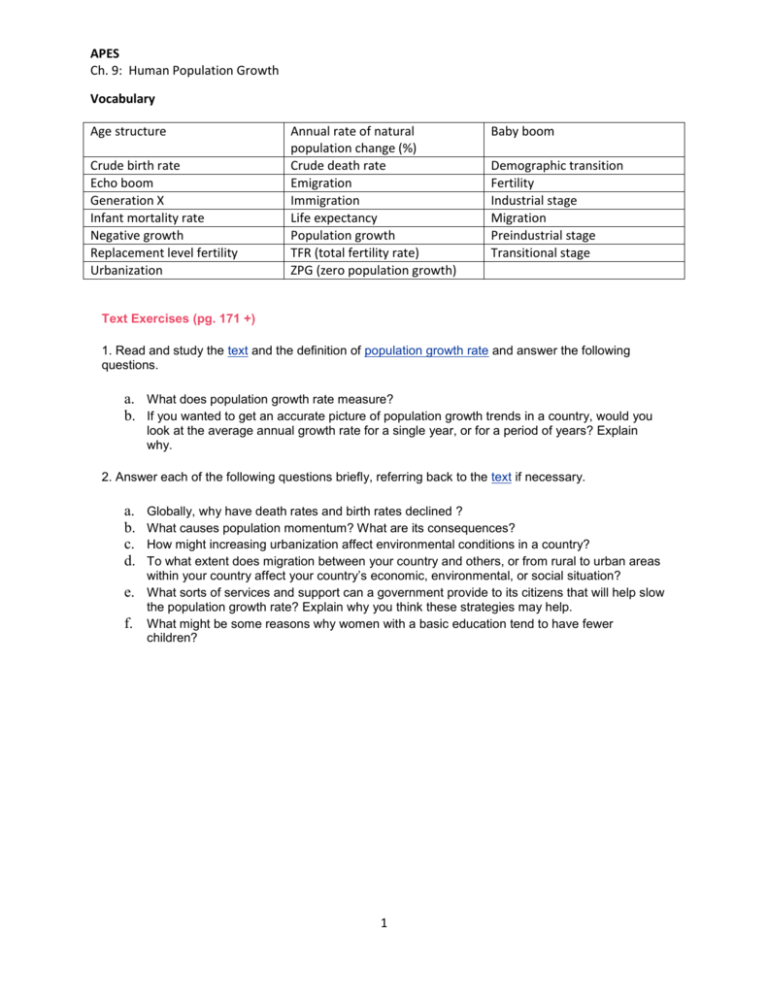
APES Ch. 9: Human Population Growth Vocabulary Age structure Crude birth rate Echo boom Generation X Infant mortality rate Negative growth Replacement level fertility Urbanization Annual rate of natural population change (%) Crude death rate Emigration Immigration Life expectancy Population growth TFR (total fertility rate) ZPG (zero population growth) Baby boom Demographic transition Fertility Industrial stage Migration Preindustrial stage Transitional stage Text Exercises (pg. 171 +) 1. Read and study the text and the definition of population growth rate and answer the following questions. a. What does population growth rate measure? b. If you wanted to get an accurate picture of population growth trends in a country, would you look at the average annual growth rate for a single year, or for a period of years? Explain why. 2. Answer each of the following questions briefly, referring back to the text if necessary. a. b. c. d. e. f. Globally, why have death rates and birth rates declined ? What causes population momentum? What are its consequences? How might increasing urbanization affect environmental conditions in a country? To what extent does migration between your country and others, or from rural to urban areas within your country affect your country’s economic, environmental, or social situation? What sorts of services and support can a government provide to its citizens that will help slow the population growth rate? Explain why you think these strategies may help. What might be some reasons why women with a basic education tend to have fewer children? 1 APES Ch. 9: Human Population Growth 3. Calculate the annual population growth rate for countries A, B, and C using data provided in the table below and this formula: Population increase in a year ____________________________ X 100 = Annual population growth rate % Population at the start of the year Note: Average annual population growth rates for a period of years provide a better picture than annual rates. For this reason, they are used in the Data Table. Calculating any growth rate for a period longer than a year requires more complicated mathematical formulas than the one used to calculate an annual rate. Country Population at the start of the year Population at the end of the year Population increase during the year Country A 22,000,000 22,400,000 Country B 8,500,000 8,800,000 Country C 400,000,000 410,000,000 Annual population growth rate (%) 4. Population growth rates are small numbers, but they have large effects on population. To see what this means, complete the following exercises. a. Assume the world population at the beginning of 1999 was about 6 billion. If the projected b. c. d. 2000 average annual population growth rate for the world was 1.1%, how many more people would be added to the world by 2001. If the 2000 world population grew at .2%, the same projected rate as the United Kingdom, how many more people would be added to the world by 2001. If the 2000 world population grew at 1.7%, the same projected rate as Kenya, how many more people would be added to the world by 2001. Use your answers to questions 3a,b, and c to make a general statement about the relationship between population growth rates and the change in the size of a population. 5. Use the calculations and data in the table below to calculate the birth rates, death rates, and population growth rates for three countries and fill in the missing information. Number of births (%) __________________ X 100 = Birth rate Population Number of deaths (%) __________________ X 100 = Death rate Population Birth rate (%) - Death rate (%) = 2 Population growth rate (%) APES Ch. 9: Human Population Growth Country Births Deaths Population Country A 662,000 297,000 33,100,000 Country B 411,000 191,800 27,400,000 Country C 211,200 96,800 4,400,000 Birth rate Death rate Population growth rate 6. If a population growth rate is low, population is growing slowly. If it is high, population is growing rapidly. To understand what "slow" and "rapid" mean, it helps to look at how long it will take different countries growing at different rates to double their population. a. The number of years it takes a population to double can be estimated by dividing the number b. c. d. 70 by that population's growth rate. Calculate the doubling time of populations growing at the rates shown in the key to the map. Is three percent a rapid growth rate? Explain. Is two percent a rapid growth rate? Explain. Is one percent a rapid growth rate? Explain. Use the projected population data in column 2 of the Social Data Tables for 1998–2015 to calculate the population doubling time for these countries: your country, Canada, Chile, Finland, India, Zambia. Assume that your country has an average annual population growth rate of 1.8%. It will take 39 years for your country’s population to double. What changes will your country need to make to deal with this growth in population? Consider such issues as housing, health care, food supplies, transportation, employment, education, and the environment. Do you think your country presently has the resources to handle this rate of population growth? Why or why not? 7. What consequences might a declining population growth rate have on a country’s economy and environment? 3

